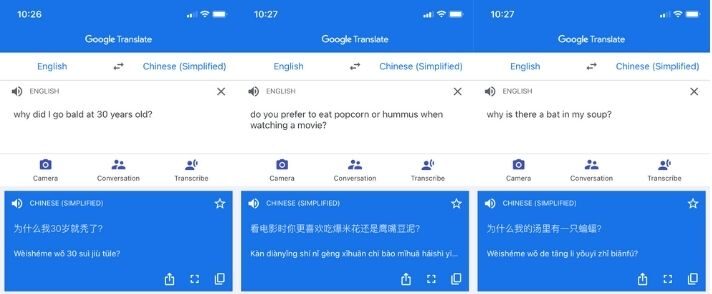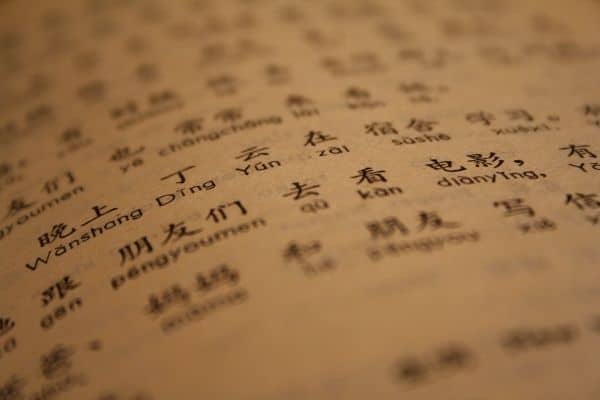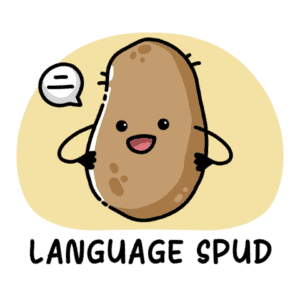
If you haven’t been told that “Chinese grammar is really easy!” by a native speaker or another learner of Mandarin Chinese, then I can guarantee you will be at some point.
But is it true?
Yes, but only to an extent.
Read on to find out how you can tackle Chinese grammar in the most efficient way possible. If you hate reading, you can consume the content of this blog post in video form instead!
Is Chinese Grammar Easy? | Strategies for Learning Chinese Grammar | Translator Apps | Chinese Learning Apps | Sentence Mining | Textbooks | Extensive Reading | Extensive Listening | Chinese Media
Is Chinese Grammar Easy?
Now, most people find studying grammar structures to be the most boring part of language learning, but luckily with Mandarin Chinese, there are some things to be positive about.
I’m going to keep things simple and point out the differences you’ll encounter as you start to learn.
1. Chinese follows the same basic sentence structure as English, with a subject-verb-object (SVO) formula.
| Subject | Verb | Object | Translation |
| 我Wǒ | 吃chī. | 肉。ròu. | I eat meat. |
| 你Nǐ | 玩wán | 游戏。yóuxì | You play games. |
| 他Tā | 喝hē | 果汁。guǒzhī | He drinks juice. |
2. No verb conjugations. None of this I am, we are, he/she is nonsense in Chinese. The verb stays the same no matter what.
3. No plurality. Nouns in English and a lot of other languages are altered in their plural form, usually by adding ‘s’ to the end of the word (eg. one cat, two cats, many cats). In Mandarin, the noun stays the same.
4. No tenses. This might be hard to believe, but it’s true. In Chinese, you simply place the time closer to the beginning of the sentence – no need to change the verb! If an action has finished, you just stick a ‘了’ at the end of the clause. (This actually takes a lot of practice and isn’t as simple as it seems.)
5. Simple possessives. All possessives in Chinese are expressed by adding 的 (de). In English, we have a possessive form of each pronoun and add an ’s to make a name possessive.
Now, it’s all well and good saying how easy Chinese grammar is, but we all still have to actually learn it to be able to speak Mandarin Chinese.
That we do, and the following strategies will help considerably.
Strategies for Learning Chinese Grammar
Fundamentally, there are two approaches to learning grammar, and no matter what type of learner you are, you’ll have to adopt both of them.
The ‘grammar pattern extractor’ – This is the kind of person who can read the explanation of a grammar pattern in a textbook or course (for example, ‘subject + verb + object’) and then replicate it easily thereafter. My father is like this. He speaks multiple languages and told me that he was always very good at remembering grammar rules and using examples. I’m the total opposite kind of learner, so I’m probably adopted…
The ‘repeat exposure’ learner – This is most people, including me. I need to actively learn, read, and hear grammar patterns over and over again before it sticks in my brain. To be fair, most ‘grammar pattern extractors’ need this as well, they just tend to have better memory retention.
Anyway, the following tools outlined in this post suit both kinds of learners. They’re not in order of preference or effectiveness, and I strongly suggest you adopt all measures in your pursuit of Mandarin fluency.
Remember that the key for language learning is exposure, repetition, and variety, and grammar is included in all of that.
Translator Apps
Translator apps sometimes get a bad rap, but they can be incredibly useful and they’re improving all the time.
I mean sure, if you copy and paste pages of Walt Whitman classics into Google Translate then you’re going to get some interesting Mandarin translations. However, if you’re translating more simple language, then the results are actually quite accurate.

I’ve written an article on the best Mandarin Chinese translation apps which you can find here.
Referring to a translator app might not form a large proportion of your studies, but it’s still a very useful aid for forming sentences.
Your translator app might not return a sentence that a native Chinese speaker would use exactly. However, at this point, you’re not aiming for perfection. You’re aiming to get a better understanding of the language in general, and you’re aiming to be understood.
Chinese Learning Apps
There are a bajillion apps out there for learning Mandarin, but not all of them were created equally. Also, not all of them will help you with grammar, either. For a rundown of my favourite Mandarin learning apps, check out The 21 Best Apps for Learning Mandarin Chinese.
In other posts I’ve written, I usually recommend and lump together free apps such as HelloChinese, Duolingo, and ChineseSkill together for newbies to try out. Why? Because they are very similar apps that do more or less the same thing. Basically, each 5-minute mini-lesson offers a small set of vocabulary and one new grammar point.
Although these apps can’t be relied on for all your Mandarin learning needs, they will get your surprisingly far if you use them daily for a few months.
For the best apps for learning grammar specifically, read on…
Anki
One of the most popular flashcard apps on the market. The customisation options on Anki cards are massive, and because the app has been around such a long time, there are so many study lists already available to access.
I strongly recommend downloading AllSet Learning’s Chinese Grammar Wiki. It includes all grammar points from HSK 1-6 and offers loads of example sentences. If you only want to download the deck according to your level, you can do that here.
Memrise
Memrise is another flashcard app that’s slightly more gamified than Anki, but essentially does the same thing. There are more courses available on Memrise as well, including the Mandarin Chinese Course which takes you through a lot of basic sentences
You can also find the Chinese Grammar Wiki courses there as well. (Yes, it is that good).
With the free version of the Memrise app, you have access to all of the courses in the Memrise catalog.
Sentence Mining
Sentence mining is the memorisation of sentences through repeated exposure, most of the time using SRS (spaced repetition software). This is most commonly done with flashcards to learn individual characters and new words, but it can be just as effective when it comes to learning sentences as well.
Why is the main benefit of sentence mining? You’re learning new words, characters, and sentence patterns through context.
You can start sentence mining as early as you like, but most people start doing it after they have learned the most basic grammar structures and have memorised the most frequently used words.
The three most popular sentence ming tools on the market are Glossika, Speechling, and Clozemaster. Speechling is free and does pretty much all of the things Glossika can do. Clozemaster does things a little bit differently, but it’s very good value for money and very effective for remembering new vocabulary.
NOTE: there are two diverging methods when it comes to studying sentence mining:
- Volume: study 10,000 random sentences to give you a pretty solid base of the language. See the above resources for this kind of thing, as you’re unable to make your own sentence flashcards in both Glossika and Speechling.
- Tailored: create your own sentence cards based on your own study plan. For example, taking sentences from a textbook you’re learning so you can really drill it into your brain. If you’d prefer to study this way, you’ll need to use Anki.
Textbooks

Because of the desperation of new companies trying to shoehorn technology into literally every corner of our lives, the good old-fashioned textbook comes under a lot of criticism these days.
Well, I’m here to defend the textbook because the benefits of textbooks are numerous if used correctly. A textbook can…
- Be used as a solid foundation for learning new language.
- Progressively build on language knowledge with new vocab and grammar patterns.
- Offer thorough explanations of grammar patterns.
- Offer quality reading and listening materials (essential).
- Offer opportunities to put new language into practice with activities.
- Be incredibly cheap.
Having said that, not all textbooks were created equally, and some are boring as hell. The following are my three recommendations (and yes, I have used them all personally):
HSK Standard Course
The biggest benefit of learning directly in line with the HSK is you have a clear mark of progress, and you are certain to be learning the most commonly used words and grammar patterns in Mandarin as you move forward.
The content is structured well enough and the topics will be useful to you. Although the HSK books can be a bit ‘stiff’ sometimes, you won’t end up speaking like a robot if you follow them, and the workbook audio will mirror the format of the audio on the HSK exam.
Boya Chinese
The Boya series is my personal favourite, and they are the core textbooks used on some Mandarin university courses in China. This book was the general course textbook for the Chinese language course to foreigners when I studied at Sun Yat-Sen University in Guangzhou, which has since been discontinued.
The reason I like it is that the topics are more relevant, and the same goes for the vocabulary in each topic. It’s an easier read with more dynamic audio, whilst still managing to stay fairly aligned to the HSK in terms of content.
Every section of the book has a conversation introducing the new grammar points and vocabulary.
Developing Chinese
The Developing Chinese series is another comprehensive textbook used on some language courses in Chinese universities.
The first two books (the second one found here) are all you need to take you from a complete beginner to a lower intermediate. Each lesson will bring in commonly used grammar points and new vocabulary.
The handwriting booklet is pretty good, too.
For a more in-depth guide on textbooks, check out Learning Chinese: The Best Textbooks for Beginners
Extensive Reading

Remember what I said about repeated exposure earlier?
Nothing, and I mean nothing, gives you more repeated exposure to a new language (specifically, grammar and sentence patterns) than extensive reading.
Now, you might not be concerned that you can’t find reading material suitable to your level if you’re a beginner or intermediate learner. That’s why I recommend graded readers.
Rainbow Bridge Reader – Loads of short stories from beginner learners right up to advanced. Loads of starter books for those at HSK 1, and then higher-level stories for above and beyond. These stories are very much centered around traditional Chinese culture and history.
Mandarin Companion – Buy them. Read them all. By far my favourite set of graded readers. The stories are interesting and the language is suited to high beginner/lower intermediate learners. They go from breakthrough level books(150-character vocabulary) to level 1 (300-character vocabulary) to level 2 (450-character vocabulary). Available in simplified and traditional characters.
Selected Abridged Chinese Contemporary Mini-Stories – Another solid collection of graded readers going from 500-word vocab level up to 3000-word vocab level. Loads of reading content but the repetitive theme of the stories can get a little samey and boring. However, I still recommend reading them to get a fuller understanding of the language and recent history of China through famous Chinese storytellers.
Pleco – Inside the Pleco add-ons section you’ll find a huge collection of graded readers (some of which are mentioned above) that you’ll be able to read inside the app. You can also get your hands on compilations of articles from The Chairman’s Bao suited to your level. I have the HSK 5 collection – 194 pages of very interesting news articles to read on my phone whenever I want!
If you’re seriously addicted to apps and technology, there are two really good graded reader apps…
Du Chinese
One of two wonderful subscription reading apps that I wholeheartedly recommend. You can read news articles and short stories in Chinese based on your current HSK level, whilst saving difficult words to a flashcard function. There is also audio available for every text and a whole other handy bunch of bells and whistles.
The Chairman’s Bao
Very similar to Du Chinese with more content but one or two fewer features. You can purchase a collection of Chairman’s Bao articles through Pleco to read within the text reader function. Incredibly useful and totally worth the money.
Extensive Listening

Perhaps the biggest mistake new learners make when looking for good listening content is spending too much time looking for the perfect listening content, which doesn’t exist. Instead, they end up wasting loads of time looking for the holy grail podcasts, and that time could have been spent actually listening to Mandarin Chinese.
I’ve said previously that listening in Chinese is objectively hard for a number of reasons, but how to overcome it?
Practice, practice, and more practice.
Also, try engaging with the following techniques…
- Shadowing – shadowing is essentially copying and imitating what you hear. This is a very difficult skill to refine, so you’ll want to slow down the audio in the beginning. Shadowing is incredibly effective when it comes to remembering language and improving your pronunciation.
- Transcribing – writing down what you hear or at least reading the transcripts of what you’re listening to is also a popular and effective technique. This is a great way to learn grammar patterns.
- Repetition – listening to a podcast once isn’t going to do much. On the other hand, listening to the same podcast 10, 20, or 30 times will do a lot for your language skills. If might sound boring, so that’s why you have to find stuff that you’re interested in.
Find good listening content with the following…
Chinesepod – I’ve used Chinesepod for years and it’s one of my favourite resources for learning Chinese. Basically a huge database of short podcasts on a range of different topics. For beginners, they have a short dialogue in Mandarin and then break it down in English afterward. I’ve written a full review of Chinesepod here.
Chinese Class 101 – ChineseClass101 isn’t quite as good as Chinesepod but it still has a lot to offer and the beginner lessons are really good. It follows a similar format to Chinesepod but is slightly more structured in terms of content and study paths. There aren’t as many interesting topics compared to Chinesepod and the advanced lessons aren’t up to much (something the rest of the internet says).
Chinese Media
Pretty much every Chinese TV show, movie, news bulletins, and music video comes with Chinese subtitles. This is incredibly helpful for Mandarin learners.
But simply bombarding your ears and eyes with as much language as you can isn’t going to get you very far in the early stages. Remember to incorporate shadowing, transcribing, and repetition wherever you can.
If you want some suggestions for interesting Chinese media, check out the following posts:
- Learn Mandarin with Film | 101 Awesome Chinese and Taiwanese Movies
- 100+ Podcasts for Learning Chinese | Beginner to Advanced Material
- 101 TV Shows for Chinese Learners | Drama, Action, Comedy, and More!
- 57 of the Best YouTube Channels for Learning Mandarin Chinese
Summary
Grammar is one of the simpler areas of learning Mandarin Chinese, but it still requires our attention as learners.
My advice is to do your best to understand the technical structures of the language through a textbook, and then double down on exposure to the language thereafter. You are much more likely to remember grammar patterns with repeated exposure to them in a variety of ways. i.e reading, listening, and creating language yourself.
If you don’t understand the sometimes rigid and academic explanations of Mandarin, that’s OK. It’s amazing how repeated exposure irons out the understanding of Mandarin Chinese!
